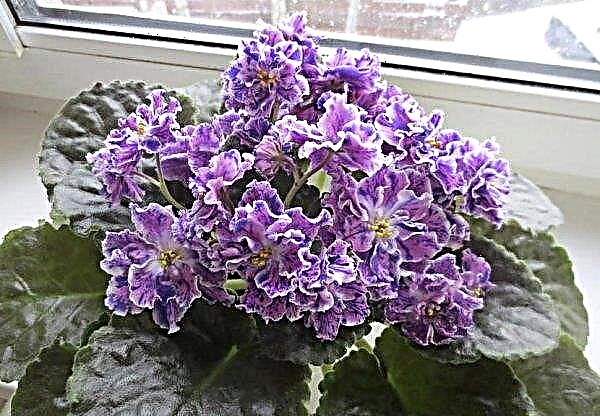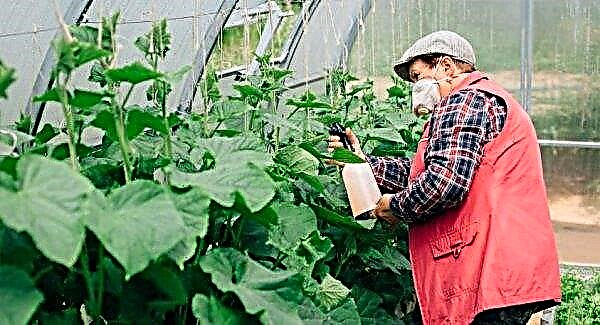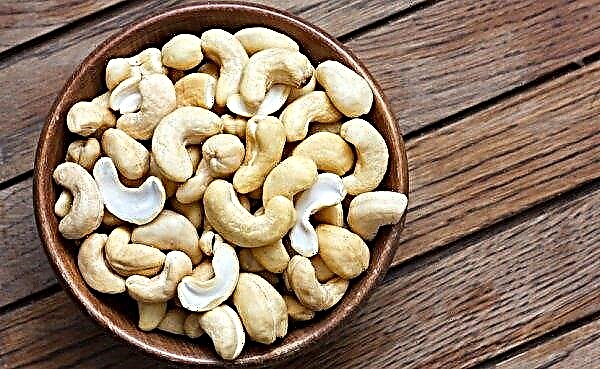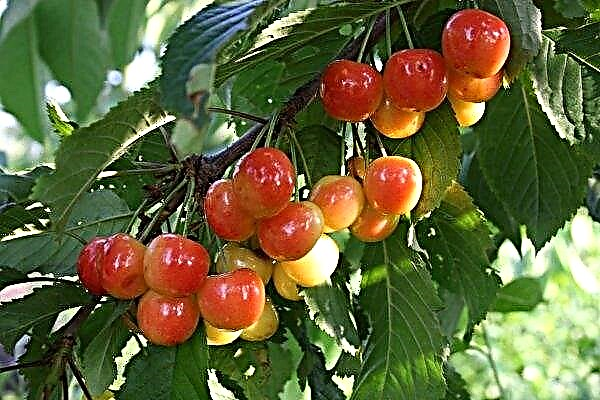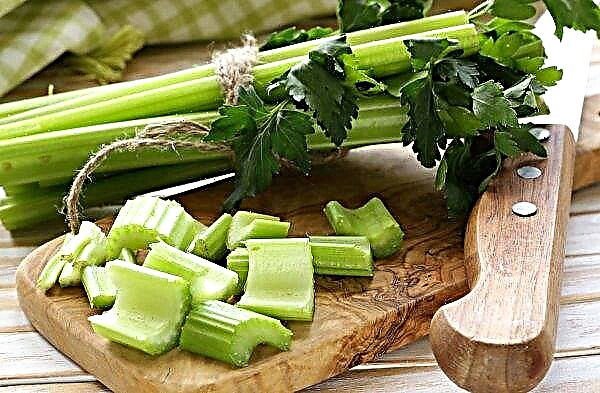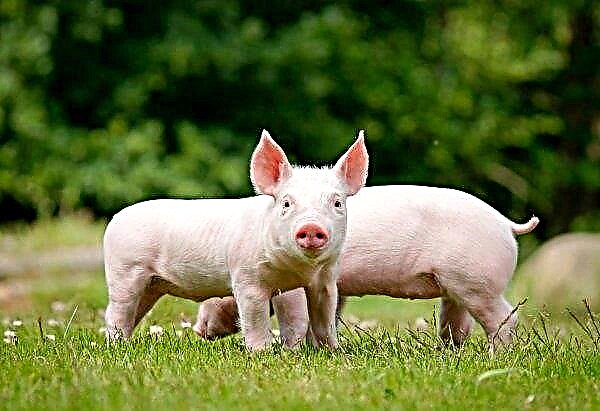Carrots are an important source of carotene and other beneficial elements in the winter. In addition, it is one of the most important and productive vegetables grown by man. Among the varieties with high taste and productive qualities, the Dutch variety Cascade is distinguished.
Description and characteristics of the variety
Carrot Cascade is a 1st generation hybrid and was bred by Bejo Zaden (Netherlands). In 2001, the variety was listed in the State Register of the Russian Federation and zoned in the Central region.
Shape and size
The cascade is a variety of Chantane carrots. The vegetable has a semiconical shape with a slightly sharpened rounded end. The length of the root crop varies from 18 to 23 cm, and the diameter is 3-4 cm. The surface of the vegetable is smooth, leveled.

Taste qualities
Cascade carrots contain a lot of carotene (21 mg / 100 g), which causes its intense orange color. The root of the root crop is also orange, has a small size. The taste of carrots is sweetish and juicy. It contains 8.2% sugars and 14.3% solids.
This carrot is good for fresh consumption, preparation of salads and other dishes, for baby and diet food. In addition, an orange vegetable is perfect for obtaining juice - 1 kg of root crops gives 0.5 l of juice.
Did you know? In ancient times, carrots were purple, yellow and red. At the same time, both tops were used for nutrition and for treatment. An orange root crop with a high carotene content was bred due to the efforts of the Dutch only in the 17th century.
Variety Productivity
The volume of carrot harvest depends on the type of soil and agricultural cultivation technique. The best yield of the variety is on loose soils, although it can show good productivity on medium-hard soils.
The highest yield was obtained in the Vladimir region, where 709 tons of carrots were harvested from 1 ha. On average, the yield of the variety is in the range of 4.5–7.5 c / ha. Cascade carrots can be harvested mechanically. Marketability of root crops - 93%.
Ripening dates
This vegetable has a medium-late ripening period. Its crop begins to be harvested on the 120-130th day since the emergence of seedlings. This is the technical maturity of the vegetable, and selective harvesting of individual root crops can be done already in July.
Grade Immunity to Disease
Cascade variety has good immunity and shows itself well in different climatic conditions. It is resistant to fungal diseases - alternariosis, black rot, cercosporosis.
Did you know? The maximum amount of carotene is absorbed from boiled carrots with the addition of vegetable oil. Raw vegetables are digested worse by the human body.
Advantages and disadvantages of the variety
- Variety of carrots Cascade fell in love with vegetable growers for the following qualities:
- great taste;
- high carotene content;
- presentation of products;
- stable high productivity;
- good keeping quality;
- unpretentiousness;
- suitability for machine cleaning.
 The disadvantage of the Cascade variety is one - the inability to use its own seed material, since it is a hybrid (F1).
The disadvantage of the Cascade variety is one - the inability to use its own seed material, since it is a hybrid (F1).
Features of sowing and planting care
To obtain high yields of orange root crops, you must follow the simple rules of agricultural technology of this crop. For planting a vegetable, you should choose a suitable site and prepare the seed material for sowing, and after the plants have sprouted, properly care for them.
Dates and place
Check out

To harvest early root crops, practice winter sowing. However, this method cannot be used in areas with harsh winters or with thaws, after which frosts return.
Therefore, usually preference is given to spring planting, when frosts are no longer expected.
If carrots are needed for storage during the winter period, then sowing is recommended to be carried out on days when the temperature in the daytime is set at + 15 ... + 18 ° С. The soil should have time to warm up to + 5 ... + 7 ° С.
Soil acidity and crop rotation
Carrots prefer to grow on neutral (6–7 pH) sandy loam, loamy and peaty soil. You should not plant this vegetable where carrots themselves, as well as parsley, parsnips, dill and beans, previously grew. Well, if this crop was preceded by potatoes, cucumbers, zucchini, cabbage, tomatoes, garlic and onions. In the spring, the plot should be leveled with a rake. The plot for planting should be prepared in the fall and introduced during the digging of fertilizer beds. At the same time, for 1 m² it is necessary to take 30 g of superphosphate, 15 g of potassium, 20 g of nitrogen and 2-3 kg of humus. If the soil on the future carrot bed has a high acidity, it should be liming.
In the spring, the plot should be leveled with a rake. The plot for planting should be prepared in the fall and introduced during the digging of fertilizer beds. At the same time, for 1 m² it is necessary to take 30 g of superphosphate, 15 g of potassium, 20 g of nitrogen and 2-3 kg of humus. If the soil on the future carrot bed has a high acidity, it should be liming.
Important! To reduce acidity, ash and dolomite flour must be added to the ground.
How to prepare seeds for planting
Seed before planting requires preparation in order to improve its germination and protect against the appearance of certain diseases.
As a rule, 4 methods of seed treatment are used:
- Place the seed for 1 day in water with a temperature of about + 30 ° C. Change the water at least 6 times.
- Use ash solution. To do this, pour 1 tbsp in warm water. a spoonful of ash and wet the seeds. Then wash the seeds with clean water, wrap them in a piece of cloth and place on the shelf of the refrigerator, where they hold for 2 days.
- Pour the seeds into a bag of cotton cloth and dip into water heated to 50 ° C, and after 2-3 minutes, transfer to cold water to cool.
- Bubbling seeds (in the presence of a bubbler). To do this, place them for 20 hours in a solution of Epin or Silk preparations with oxygen saturation.

Germination of seeds of the Cascade variety is good. Therefore, in order not to carry out work on thinning the beds and save seeds, you can plant them on the adhesive tape at a distance of 2-3 cm from each other.
Watering and loosening the soil
To get a rich harvest of orange root vegetables, you need to organize the correct watering of the carrot beds. During irrigation, the soil should be moistened to a depth of 0.3 m. The next day after watering, it is recommended that the soil be loosened and weeds removed at the same time.
Check out more

Excessive moisture is also unacceptable, as root crops begin to crack, become covered with small shoots, and the tops are growing too much.
Basically, carrots are irrigated once every 7 days. Initially, watering is carried out based on the proportion of 3 liters per 1 m². Then, after the second thinning, the irrigation volume reaches 10 liters. With the active growth of the culture, the amount of moisture is increased to 20 liters.
For 1.5–2 months before harvesting, plantings are watered once every 10–14 days at the rate of 10 liters per 1 m². 2 weeks before harvesting root crops, watering should be stopped.
Fertilizer and thinning
For the entire growing season of carrots of the Cascade variety, it is necessary to carry out 2 dressings:
- 21–28 days after emergence of seedlings;
- 2 months after the previous fertilizer application.

For feeding, you need to make such a nutrient solution (per 1 bucket with a volume of 10 l):
- 1 tbsp. a spoon of nitrophoska;
- 0.5 l of ash;
- 20 g of potassium nitrate;
- 15 g of urea and double superphosphate.
Fertilizing should be carried out along with the irrigation procedure. Thinning planting twice. This is first done when the plant forms a third leaf. This usually occurs 3-4 weeks after planting the seeds. The process itself is carried out after abundant wetting of the beds. At the same time, a gap between plants of 2–2.5 cm is made. Second thinning is carried out 3 weeks after the first procedure. Between root crops leave a distance of 4.5-5 cm.
Important! Thinning carrots is best done in the evening, because during the day the smell of a vegetable can attract insect pests. Torn plants need to be moved away from planting, so that the aroma is not noticeable.
Pest, disease and weed control
Carrots can infect various diseases, as well as attack pests. Therefore, it is important to know what measures should be taken when a particular problem occurs.
Diseases such as bacteriosis, septoria, phomosis and rot can significantly reduce yields. Bacteriosis infection occurs through affected seeds or plant debris. Therefore, seed should be decontaminated before planting, and tops and other vegetation should be removed from the beds. For disinfection, a solution of Tigama is well suited.

Signs of septoria are small chlorotic spots on the leaves of the root, which after a while acquire a brown color. High humidity contributes to the rapid spread of the disease.
To combat septoria, treatment is carried out with a 1% Bordeaux mixture with an interval of 10-12 days. Heavily affected specimens must be torn out and disposed of.

Rot (gray, white, red, black) appears during storage. To eliminate the disease, soil with a high level of acidity should be grown, nitrogen-containing fertilizers applied, and regular cleaning of carrot plantings from weed grass.
Before placing vegetables in storage, they should be sprinkled with chalk. Be sure to follow the storage rules of these root crops. Red rot is detected in the form of brown spots on carrots, in the place of which black sclerotia of the fungus appears over time.
Manure, which is used as fertilizer, can provoke the disease. Black rot can be found in the dark putrid areas on the vegetable. Ill specimens should be pulled out.

Carrots can also be attacked by pests such as carrot flies, winter scoops, wireworms and slugs. Deeper can be collected by hand, if there are not many. It is also good to use traps: for this purpose, cans of beer are buried in the ground.
To combat insect pests, insecticidal preparations such as Anometrin, Revikurt, Etafos are used. To scare arthropods, you can also plant onions, garlic, marigolds or marigolds in the aisles.
Harvesting and storage
Cascade carrots are harvested after 120-130 days. Root crops are harvested as they grow and are needed since July. And when planting in the last decade of April, carrots can be harvested in August. In the summer, young carrots are torn out for eating, but the root crops that remain in the ground are gaining mass.
Important! If, instead of sand, carrots of onions are taken to store carrots, this will help prevent the process of decay, since it has bactericidal properties. When the husk is not enough, it is better to make a decoction of it and dip the root crops into it, and then dry it before storage.
To collect these vegetables, you should choose a dry and clear day. From light soil, root crops can be pulled out of the tops, and from a heavier soil they dig them out with a shovel. Then the harvested is sorted out, discarding specimens damaged by mechanical means or diseases.
At the selected root crops, the tops are cut to the very head, then they are dried under a canopy for a couple of days and transferred to the storage. For storage, a cellar or basement is well suited. Carrots are placed in boxes of wood (or plastic) and sprinkled with sand.

So, Cascade carrots have a great taste and contain a lot of carotene. Agricultural cultivation of a variety is typical of carrots, and compliance with all the rules of cultivating a vegetable will help to regularly receive an excellent crop of healthy root crops.

